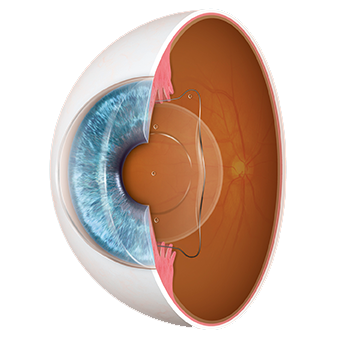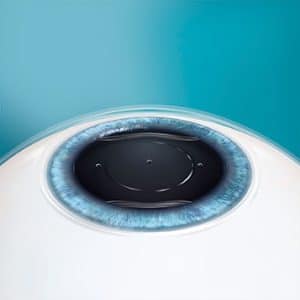What is EVO ICL lens?
The Implantable Collamer Lens (ICL) for nearsightedness and astigmatism is a refractive lens also known as a phakic IOL. “Phakic” meaning that the natural lens of the eye is in place, and “IOL” meaning intraocular lens, or a lens inside the eye. The EVO ICL is a posterior chamber implant that is introduced through a small incision in the eye and is placed behind the iris (the colored part of the eye), and in front of the natural crystalline lens in order to improve your nearsightedness and astigmatism.

Benefits of EVO ICL
- Provides clear, sharp vision 1,2
- 20 to 30 minute procedure
- Quick recovery time
- Removable by your doctor
- Offers UV protection
- Not visible once in place
- Can treat nearsightedness with or without astigmatism
- For patients who may not be candidates for
LASIK or other vision correction procedures
due to thin corneas 3,4 - Does not cause dry eye syndrome 5
- Excellent vision both day and night 6,7
- Over 2 million ICLs distributed world-wide
99.4% of patients surveyed would have the - EVO lens procedure again 8
Easy 20-30 Minute Surgical Proceedure

Pre-Op Eye Exam

Eye Drops
Administered

Small Opening

Lens Insertion and
Positioning

Post Op & Check-up

Cost and Financing for EVO ICL
Is EVO ICL Right for Me?
EVO ICL is well-suited for a wide variety of people. Ideal candidates for EVO ICL are aged 21 to 45 with nearsightedness, with or without astigmatism, and have maintained a stable prescription for at least one year. If you are seeking a solution to decrease or eliminate the cost and frustration of traditional contacts or glasses, EVO may be your answer. Contact us to discuss if EVO ICL is right for you.

EVO ICL

LASIK

LASIK is a two-step laser vision correction surgery where a flap is made on the surface of the eye called the cornea, and the underlying layers are reshaped with an excimer laser to correct vision.
PRK

PRK is a laser vision procedure similar to LASIK but no corneal flap is created. The top layer of the cornea called the epithelium is removed, and the underlying tissue is reshaped to correct vision.
Our EVO ICL lens surgeons
[1] Sanders D, Vukich J. Comparison of implantable collamer lens (ICL) and laser-assisted in situ keratomileusis (LASIK) for Low Myopia. Cornea. 2006
[2] Igarashi A, Kamiya K, Shimizu K, Komatsu M. Visual Performance after implantable Collamer lens implantation and wavefront-guided laser in situ keratomileusis for high myopia. Am J Opthalmol. 2009
[3] Parkhurst G, Psolka M, Kezirian G. Phakic intraocular lens implantation in United States military warfighters: A retrospective analysis of early clinical outcomes of the Visian ICL. J Refract Surg. 2011;27(7):473-481
[4] Gimbel H, et al. Management of myopic astigmatism with phakic intraocular lens implantation. Journal of Cataract & Refractive Surgery, Volume 28, Issue 5, 883 – 886.
[5] Ganesh S, Brar S, Pawar A. Matched population comparison of visual outcomes and patient satisfaction between 3 modalities for the correction of low to moderate myopic astigmatism. Clin Ophthalmol. 2017 Jul 3;11:1253-1263.
[6] Parkhurst GD. A prospective comparison of phakic collamer lenses and wavefront-optimized laser-assisted in situ keratomileusis for correction of myopia. Clin Ophthalmol. 2016 Jun 29;10:1209-15.
[7] Ganesh S, Brar S, Pawar A. Matched population comparison of visual outcomes and patient satisfaction between 3 modalities for the correction of low to moderate myopic astigmatism. Clin Ophthalmol. 2017 Jul 3;11:1253-1263.
[8] Packer M. The Implantable Collamer Lens with a central port: review of the literature. Clinical Ophthalmology 2018: 12: 2427–2438






